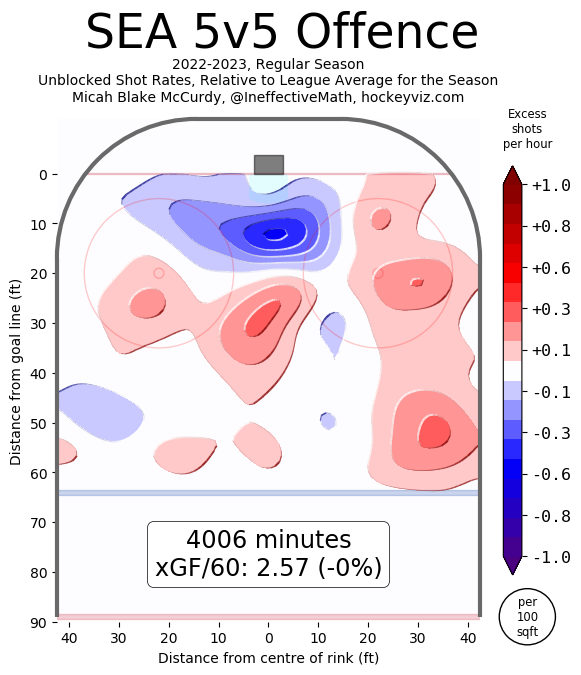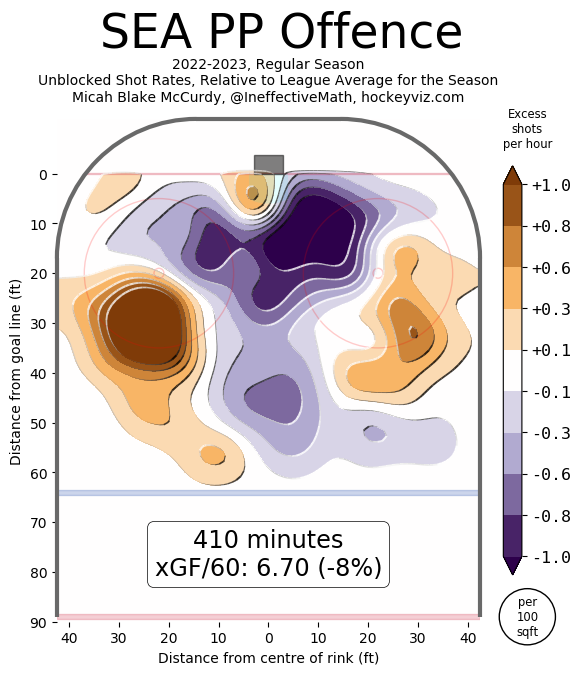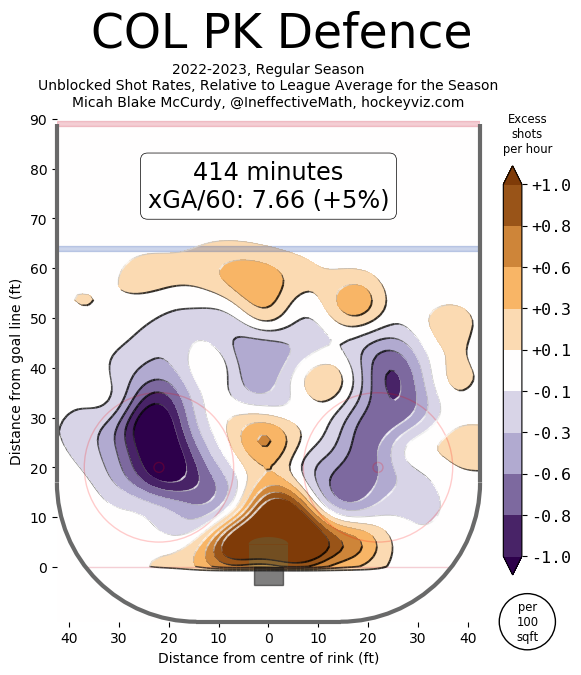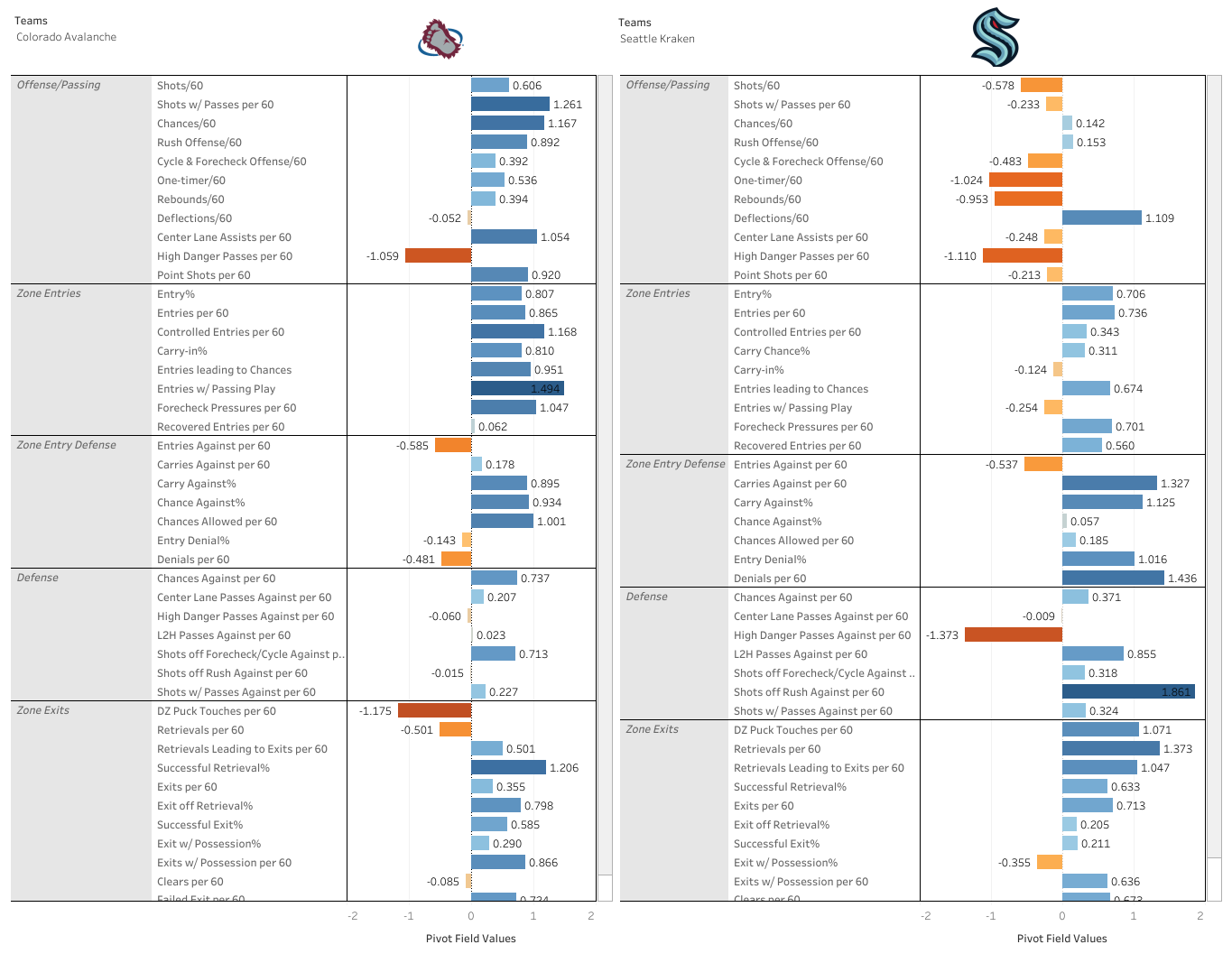© 2025 ALLCITY Network Inc.
All rights reserved.

The matchups are all set and the Colorado Avalanche’s reward for winning the Central Division is taking on the Seattle Kraken in the franchise’s first-ever foray into postseason hockey.
Before we get into where we’re going, let’s talk about where we’ve been.
Colorado finished the regular season 1st in the Central with 109 points and a 51-24-7 record.
Seattle finished 4th in the Pacific Division with 100 points and a 46-28-8 record.
Season Series
Seattle finished 2-0-1 against the Avalanche this year with games coming in October, January, and March. The results were:
October 21, 2022: Seattle 3, Colorado 2
January 21, 2023: Colorado 2, Seattle 1 (SO)
March 5, 2023: Seattle 3, Colorado 2 (OT)
Injuries were a factor as Devon Toews missed the first game, Cale Makar missed the second game, and Josh Manson missed the third game. All three are expected in the lineup against the Kraken when the series opens next week.
Pavel Francouz played the first two games against the Kraken with Alexandar Georgiev manning the net for the final game.
The other factor to consider is that each of the last two games featured an Avalanche team on the second half of a back-to-back while the Kraken were inactive the night before. This is the classic “scheduled” loss scenario and both games were low-scoring slogs.
At 5v5, Seattle had the following results against the Avs in their three matchups:
- Corsi: 146-119
- Shots on goal: 80-57
- Goals: 5-4
- High-danger chances: 29-28
The one 5v5 area I look at where Colorado had the advantage was scoring chances with a 62-60 advantage.
Given the SEGABABA status of the last two games and that two of these games were against Pavel Francouz and not Alexandar Georgiev, it’s hard to take any of the results too seriously here. Philipp Grubauer got all three starts against the Avs and he was the guy who took the net in their regular season finale. I’m not 100% on who will start Game 1 in net, but for now we’re going to look more broadly at how the teams matchup before digging into specific players.
Let’s compare the teams at 5v5 in the form of heat maps.
Who are the Kraken?
Let’s start with Seattle. They were more of a “score by committee” kind of team this year but Jared McCann did lead them in scoring with 40 goals and a 70-point season. Their top five went as follows:
- McCann – 70 points
- Vince Dunn – 64 points
- Jordan Eberle – 63 points
- Matty Beniers – 57 points
- Yanni Gourde – 48 points
Former Av Andre Burakovsky was their leading scorer for much of the season but injuries wrecked his year and he will miss this series after recently having surgery.
To the heat maps we go. Keep in mind the percentages are relative to league average. Offensive numbers you want to be positive and defensive numbers you want to be negative.




Here you have a Kraken team that is league average offensively, very good defensively, and with two special teams units heading in opposite directions.
The power play’s underlying numbers suggest a poor performer with the man advantage and they finished 21st with a 19.8% success rate. Only the Winnipeg Jets and New York Islanders have a worse power play among playoff teams.
These numbers suggest a very strong Kraken penalty kill, however, and that unit also finished 21st in the NHL at just a 76.7% success rate. Where is the disconnect between a strong PK that doesn’t allow many chances but too many goals?
Goaltending, of course, which sunk the Kraken entirely last season and even this playoff version remains haunted by the poor production from the crease. Here is Seattle’s goaltending woes in heat map form:

Giving up just shy of 18 more goals than expected is not the hallmark of a quality goaltending tandem. The dueling sub-.900 save percentages sported by Philipp Grubauer and Martin Jones would also suggest that this remains an Achilles heel of the team.
Where the team took its biggest leap forward this year, however, was in its goal-scoring department. While the play-driving seen above was right at league average, the Kraken finished fourth in the NHL in goals-per-game with 3.52. How?

Finishing at a very high rate will help.
Seattle finished with 209 goals at 5v5, 10 more than the record-setting Boston Bruins. They were buoyed entirely by a 10.34% shooting percentage as a team at 5v5. They are the only team to shoot above 10% at 5v5 this season. While their 90.72 save percentage at 5v5 is the 10th-worst in the NHL, their finishing is what carried them to the playoffs.
When you look back at how previous teams fared who were carried by extremely high 5v5 shooting percentages, the results aren’t pretty. Going back six years, only six teams have managed a shooting percentage north of 10 for an entire season and two of those occurred during the 56-game season. The other two were last year with the St. Louis Blues (how many 20-goal scorers does it take to lose in the second round again?) and the Minnesota Wild. This year’s Kraken are the sixth.
If it seems like I’m really hammering home the point that this unsustainably high shooting percentage is a major reason the Kraken are even here, that’s because it is.
With the completion the All-Star break in early February, Seattle’s shooting luck began to turn and their results followed. In the 33 games since then, the Kraken went a respectable 17-13-3, but their .561 points percentage was good for 16th in the league. Their goal-scoring remained strong at 3.39 per game, good for 13th in that time, but that’s a far cry from leading the league and pushing the Kraken to the top of the Pacific Division.
So they shot like crazy early in the season and as that percentage started to come down a bit, so did their results. Got it. One other piece of information I always find interesting is how a team plays in a certain game state.

In any kind of close game, Seattle is very good defensively, but looking at the ‘Down 1’ numbers is striking. This is a team that when it trails, absolutely smashes its foot on the gas to get it tied again. Once they do, they’re pretty much a league-average team, but they clearly do not like being down by a goal.
When ‘Up 1’, they keep the offense going but it’s also one of their weaker defensive states. Naturally, that’s also when opposing teams push their hardest (see: Seattle Down 1), but the Kraken do a pretty good job holding the fort.
If they get into a multi-goal game, either leading or trailing, that’s very likely the result. There just isn’t much happening in terms of giving up comebacks or sparking comebacks.
Okay, let’s see how Colorado stacks up after all of this.
Meet this year’s Avalanche
Unlike Seattle’s “score by committee” approach, the Avalanche have elite, high-end talent that changes games on a regular basis and is the focal point of opposing teams. The Avs are led by the dynamic 100-point duo of Nathan MacKinnon and Mikko Rantanen, who paced the Avs in scoring. The rest of the top five was:
- MacKinnon – 111 points
- Rantanen – 105 points
- Cale Makar – 66 points
- J.T. Compher – 52 points
- Artturi Lehkonen – 51 points
What a list that ended up being after the injury-plagued season Colorado just sat through.
Let’s see what kind of team the Avs are in heat map form.




Here are the results of an above-average hockey team. The Avs are a little better than your league average squad at creating offense, much better at preventing it, and very good at generating it on the power play. Their big bugaboo here is the penalty kill, which was atrocious early in the year and improved as the season went on.
Following the acquisition of Lars Eller, Colorado’s PK was actually 10th-best in the NHL, which is up from the 17th place (79.0% success rate) it finished at on the season. While Colorado’s offense has plenty of talent, the injuries forced constant lineup turmoil and the power play regularly had to try to find patchwork solutions on the fly.
Despite that, it finished sixth in the NHL with a 24.5% success rate. Given the 22 games they played without Makar, that’s a pretty respectable finish, even with Colorado’s abnormal cadre of defenders who can run a power play.
Unlike Seattle, there are no major outlier statistics here for me to really hammer away at. Colorado was a decent finishing team and had that backstopped by quality goaltending all season, especially from starter Alexandar Georgiev.


When you consider that $7 million was spent getting 0 games played from Gabe Landeskog, Colorado managing to have the kind of season in scoring goals they did is plenty impressive.
The Avs can score, but they aren’t the offensive juggernaut that we saw in the last couple of years. Where they’ve been surprisingly stout is in net, where Georgiev just had one of the finest regular seasons in Avalanche goaltending history.
If you’re looking for something to be concerned about with the Avalanche, it’s that they handled in-game success very poorly.

The numbers when trailing are all good. They tighten up defensively, they push play offensively and try to erase the deficit. That’s great, you like to see that.
When tied, they aren’t very good offensively but they are exceptional defensively. Even when they get the first goal, they still don’t turn it up offensively and then they start giving all kinds of ground defensively.
By far the most concerning part of this is the “Up 2” numbers. You don’t expect to have many multi-goal leads in the playoffs, but holy smokes that is a truly abysmal state of being for the Avalanche. The safest lead in hockey, at least for Colorado, really wasn’t a two-goal lead this year. They completely fell apart, becoming totally anemic on offense and bleeding chances defensively.
That might even be putting it generously. That’s bad. Really, really bad.
So if you’re reading this trying to find cause for concern, I guess Colorado getting a two-goal lead is it.
Okay, we’ve met the teams. Put it all together, AJ.
How do they stack up against each other?
I’m glad you asked! Or I guess I’m glad I asked myself on your behalf. Either way, I’m glad we’re in this room. Let’s take a look at what the two teams underlying numbers all look like when dropped side-by-side.

Two good finishing teams with two good defenses. The major differences here are that Colorado’s process and results are a little more in line and their goaltending should be a major advantage in this series.
If you really want to get into the weeds of extremely specific stuff, well, I’ve got you covered, too.

Again, this is pretty specific stuff so if your eyes are glazing over, I’ll just break it down as: Avs good at creating and preventing offense, Kraken good at preventing offense, not very good at creating offense.
When you start breaking these teams down, Colorado has major advantages in two areas: high-end talent and goaltending. The Kraken don’t really have an advantage at the top of the roster but the fact they get scoring from all four lines is a major feather in their cap.
Seattle has 13 (!!) forwards with at least 20 points this season. Colorado managed just eight, and 10 of Seattle’s broke 30 points while only seven of Colorado’s managed that. Injuries no doubt played a role here, but the big absence from Seattle’s side is Burakovsky while Colorado will certainly be without Gabe Landeskog and potentially all of Darren Helm, Denis Malgin and Andrew Cogliano to start the series.
When talking about the advantage Seattle has in depth scoring, Colorado missing three players who have all made cases to be in the lineup is just another day in the life of an Avalanche team who lost approximately 465 man games to injury this season (compared to 233 for Seattle, 82 of which were old friend Joonas Donskoi as he battles ongoing concussion problems. Get better soon, Joonas <3).
The Stanley Cup Playoffs inevitably become a war of attrition. If Seattle is looking for an edge, that they are already winning that particular war before the series even gets started is at least something, I suppose.
That’s a pretty thorough look at who the teams are on the whole. Stay tuned here at DNVR over the weekend for Part 2 as I dig into the specific player matchups and which players to keep an eye on as we prepare for the beginning of this series next Tuesday.
Comments
Share your thoughts
Join the conversation



